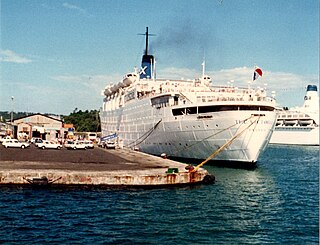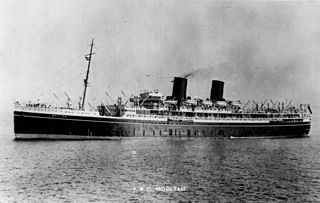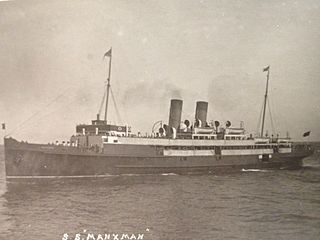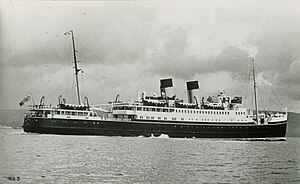
RMS Aquitania was an ocean liner of the Cunard Line in service from 1914 to 1950. She was designed by Leonard Peskett and built by John Brown & Company in Clydebank, Scotland. She was launched on 21 April 1913 and sailed on her maiden voyage from Liverpool to New York on 30 May 1914. She was given the title of Royal Mail Ship (RMS) like many other Cunard ocean liners since she carried the royal mail on many of her voyages. Aquitania was the third in Cunard Line's grand trio of express liners, preceded by RMS Mauretania and RMS Lusitania, and was the last surviving four-funnelled ocean liner. Shortly after Aquitania entered service, the First World War broke out, during which she was first converted into an auxiliary cruiser before being used as a troop transport and a hospital ship, notably as part of the Dardanelles Campaign.

The MV Bloemfontein Castle was a passenger liner. She was launched at Harland & Wolff's yard at Belfast on 25 August 1949 by Mrs Leif Egeland, wife of the High Commissioner for the Union of South Africa in London. She was completed on 25 March 1950. Built for Union-Castle Line's Intermediate service to South and East Africa, she was their first one-class ship. She took her name after the town of Bloemfontein, capital of the Orange Free State.

HMS Queen Emma was a commando troop ship of the Royal Navy during the Second World War. Built as a civilian passenger liner in 1939 by De Schelde at Vlissingen, she was named the MS Koningin Emma, after Queen Emma of the Netherlands, and operated by Stoomvaart Maatschappij Zeeland (SMZ) between Flushing and Harwich, along with her sister ship, MS Prinses Beatrix. After fleeing to Britain after the German invasion in 1940, she was requisitioned by the British Ministry of War Transport, renamed HMS Queen Emma and converted to a troopship at Harland and Wolff's yard in Belfast. During the war her main role was transporting British Commandos, and she participated in the Lofoten Islands Raid and the Dieppe Raid. She had the advantage of a high speed that allowed hit and run operations. Later designated as a Landing Ship, Infantry (Medium) she took part in the landings in North Africa, Sicily and Normandy. She operated in the Indian Ocean, and in the Dutch East Indies after the end of the war. In 1946 Queen Emma was returned to her owners and continued to operate as ferry from the Hook of Holland until 1969, when she was scrapped in Antwerp, Belgium.

Chandris Line was a Greek shipping company founded in 1960 by Antonios Chandris to operate ocean liners between Greece and Australia. Initially the company also traded under the names Greek Australian Line, National Greek Australian Line and Europe-Australia Line.

RMS Majestic was a British Ocean liner working on the White Star Line’s North Atlantic run, originally launched in 1914 as the Hamburg America Liner SS Bismarck. At 56,551 gross register tons, she was the largest ship ever operated by the White Star Line under its own flag and the largest ship in the world until completion of SS Normandie in 1935.

RMS Cedric was an ocean liner owned by the White Star Line. She was the second of a quartet of ships over 20,000 tons, dubbed the Big Four, and was the largest vessel in the world at the time of her entering service. Her career, peppered with collisions and minor incidents, took place mainly on the route from Liverpool to New York.

MS Dunnottar Castle was a British-built passenger ship with a career of more than six decades that included periods as an ocean liner, an armed merchant cruiser (AMC), a troop ship and several decades as a cruise ship. As a cruise ship she was renamed Victoria, then The Victoria and finally Princesa Victoria.

The British Rail Class 99 was a fleet of train ferries, most of which were owned by Sealink, that carried rail vehicles between Britain and mainland Europe. When British Rail implemented the TOPS system for managing their operating stock, these ships were incorporated into the system in order to circumvent some of the restrictions of the application software. This allowed them to be counted as locomotives while carrying railway vehicles in the same way as a normal locomotive would haul a train.

The first RMS Windsor Castle, along with her sister, RMS Arundel Castle, was an ocean liner laid down by the Union-Castle Line for service from the United Kingdom to South Africa. During World War 2 the Windsor Castle was requisitioned as a troopship and on 23 March 1943 was sunk by an aerial torpedo off the coast of Algeria.

RMS Mooltan was an ocean liner and Royal Mail Ship of the Peninsular and Oriental Steam Navigation Company (P&O). She was ordered in 1918 and completed in 1923. She served in the Second World War first as the armed merchant cruiser HMS Mooltan (F75) and then as a troop ship. She was retired from P&O service in 1953 and scrapped in 1954.

TSS Manxman was a turbine steamship launched in 1904 for the Midland Railway and operated between Heysham and Douglas, Isle of Man. In 1916, she was commissioned by the Royal Navy as HMS Manxman and saw action as a seaplane carrier during the First World War, after which she was acquired by the Isle of Man Steam Packet Company. On the outbreak of the Second World War she was again requisitioned as a troop ship, until she was commissioned and her name changed to HMS Caduceus. She never returned to Manx waters, and was scrapped in August 1949.

HMS Princess Beatrix was a commando troop ship of the Royal Navy during the Second World War. Built as a civilian passenger liner in 1939, she was named the MS Prinses Beatrix, after Princess Beatrix of the Netherlands, and operated by Stoomvaart Maatschappij Zeeland (SMZ) between Flushing and Harwich, along with her sister ship, MS Koningin Emma. After fleeing to Britain after the German invasion in 1940, she was requisitioned by the British Ministry of War Transport, renamed HMS Princess Beatrix and converted to a troopship at Harland and Wolff's yard in Belfast. During the war her main role was transporting British Commandos, and she participated in the Lofoten Islands Raid and the Dieppe Raid. She had the advantage of a high speed that allowed hit and run operations. Later designated as a landing ship, infantry (medium) she took part in the landings in North Africa, Sicily, Salerno, Anzio, and southern France. In 1946 Princess Beatrix was returned to her owners and continued to operate as ferry from Hook of Holland until 1969, when she was scrapped in Antwerp, Belgium.

RMS Duke of Argyll was an Irish Sea ferry that operated from 1928 to 1956. William Denny and Brothers of Dumbarton on the Firth of Clyde built her for the London Midland and Scottish Railway. When the LMS was nationalised in 1948 she passed to the British Transport Commission.
RMS Duke of Lancaster was a steam turbine passenger ship operated by the London Midland and Scottish Railway from 1928 to 1956 between England and Northern Ireland across the Irish Sea.
The RMS Duke of Rothesay was a steamer passenger ship operated by the London Midland and Scottish Railway from 1928 to 1956.

SS Zealandic was a British ocean liner initially operated by White Star Line. She was used both as a passenger liner and a cargo ship as well as serving during both world wars.
Associated Humber Lines (AHL) was created in 1935 to manage the services of various railway controlled shipping lines including port activities in the Humber area of the United Kingdom. The ownership of the respective vessels did not transfer to A.H.L and similarly the ports concerned, Hull, Goole and Grimsby, also remained under the control of the railway companies and their successors.

SS or RMS The Ramsey was a passenger steamer operated by the Isle of Man Steam Packet Company from 1912 to 1914. She had been built in 1895 as Duke of Lancaster for the joint service to Belfast of the London and North Western Railway and Lancashire and Yorkshire Railway companies. The steamer was requisitioned by the Admiralty in 1914 as the armed boarding vessel HMS Ramsey and sunk the following year.
TSS Amsterdam was a passenger and freight vessel built for the London and North Eastern Railway in 1930.
MV Ulster Monarch was a passenger ferry operated across the Irish Sea between 1929 and 1966 apart from wartime service as an infantry landing ship, HMS Ulster Monarch.
















